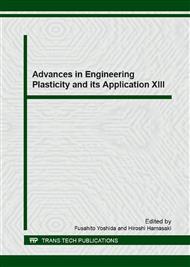p.537
p.542
p.548
p.554
p.560
p.566
p.572
p.578
p.586
Numerical Investigation on Mini Internal Gear Forging Process
Abstract:
Gear transmission system is closely related to the consumer electronics products, factory automation industry, science and technology toys, medical equipment, electric hand tools, home appliances and the low-speed high torque applications of automotive industry. In the past, the almost manufacturers produced the metal gear of transmission system mostly by machining method. The gear machining tools of relative processing are mired in difficulties when the gear was miniaturized. In terms of the way of micro forging to produce the gear transmission components, not only a high accuracy and production rate being much times of gear machining, which achieves a significant competitive advantage. This study aims to conduct a research for a mini internal gear forging formability. For this purpose, the finite element method was used to analyze the mini internal gear forging process based on a die set of involute gear profile model. From the simulation results, the characteristic of flowing field of material filled into the gear mold and the induced strain and stress distribution were observed. All findings can be significantly provided to develop the manufacturing process of mini gear forging.
Info:
Periodical:
Pages:
560-565
Citation:
Online since:
December 2016
Authors:
Keywords:
Price:
Сopyright:
© 2017 Trans Tech Publications Ltd. All Rights Reserved
Share:
Citation:


